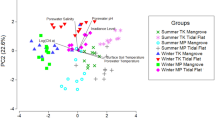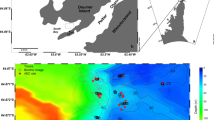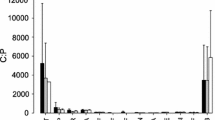Abstract
Benthic oxygen consumption and primary production were measured using the bell jar technique in deltaic and fringing mangrove forests of tropical northeastern Australia. In a deltaic forest, rates of sediment respiration ranged from 197 to 1645 μmol O2 m−2 h−1 (mean=836), but did not vary significantly with season or intertidal zone. Gross primary production varied among intertidal zones and seasons, ranging from −281 to 1413 μmol O2 m−2 h−1 (mean=258). Upon tidal exposure, rates of gross primary production increased, but respiration rates did not change significantly. In a fringing mangrove forest, benthic respiration and gross primary production exhibited strong seasonality. In both forests, rates of oxygen consumption and production were low compared to salt marshes, but equivalent to rates in other mangrove forests. The production:respiration (P/R) ratio varied greatly over space and time (range:−0.61 to 1.76), but most values were «1 with a mean of 0.15, indicating net heterotrophy. On a bare creek bank and a sandflat, rates of gross primary production and P/R ratios were generally higher than in the adjacent mangroves. Low microalgal standing stocks, low light intensity under the canopy, and differences in gross primary production between mangroves and tidal flats, and with tidal status, indicate that benthic microalgae are light-limited and a minor contributor to primary productivity in these tropical mangrove forests.
Similar content being viewed by others
References
Alongi DM (1987a) The influence of mangrove-derived tannins on intertidal meiobenthos in tropical estuaries. Oecologia 71: 537–540
Alongi DM (1987b) Intertidal zonation and seasonality of meiobenthos in tropical mangrove estuaries. Mar Biol 95:445–458
Alongi DM (1988a) Microbial-meiofaunal interrelationships in some tropical intertidal sediments. J Mar Res 46:349–365
Alongi DM (1988b) Bacterial productivity and microbial biomass in tropical mangrove sediments. Microb Ecol 15:59–79
Alongi DM (1989) The role of soft-bottom benthic communities in tropical mangrove and coral reef ecosystems. Rev Aquat Sci 1:243–280
Alongi DM, Christoffersen P, Tirendi F (1993) The influence of forest type on microbial-nutrient relationships in tropical mangrove sediments. J Exp Mar Biol Ecol 171:201–223
Boto KG, Wellington JT (1984) Soil characteristics and nutrient status in a Northern Australian mangrove forest. Estuaries 7:61–69
Boto KG, Alongi DM, Nott ALJ (1989) Dissolved organic carbonbacteria interactions at sediment-water interface in a tropical mangrove system. Mar Ecol Prog Ser 51:243–251
Bunt JS, Williams WT, Duke NC (1982) Mangrove distributions in north-east Australia. J Biogeogr 9:111–120
Clough BF (1992) Primary productivity and growth of mangrove forests. In: Robertson AI, Alongi DM (eds) Tropical mangrove ecosystems. American Geophysical Union, Washington DC, pp 225–249
Colijn F, de Jonge UN (1984) Primary production of microphytobenthos in the Ems-Dollard estuary. Mar Ecol Prog Ser 14: 185–196
Dye AH (1983) Oxygen consumption by sediments in a Southern African mangrove swamp. Estuar Coast Shelf Sci 17:473–478
Es FB van (1982) Community metabolism of intertidal flats in the Ems-Dollard Estuary. Mar Biol 66:95–108
Gillan FT, Hogg RW (1984) A method for the estimation of bacterial biomass and community structure in mangrove-associated sediments. J Microbiol Methods 2:275–293
Gocke K, Vitola M, Rojas G (1981) Oxygen consumption patterns in a mangrove swamp on the Pacific coast of Costa Rica. Rev Biol Trop 29:143–154
Golley F, Odum HT, Wilson RF (1962) The structure and metabolism of a Puerto Rican red mangrove forest in May. Ecology 43:9–19
Grant J (1986) Sensitivity of benthic community respiration and primary production to changes in temperature and light. Mar Biol 90:299–306
Holmes RW, Mahall BF (1982) Preliminary observations on the effects of flooding and desiccation upon the net photosynthetic rates of high intertidal estuarine sediments. Limnol Oceanogr 27:954–958
Kristensen E, Andersen FO, Kofoed LH (1988) Preliminary assessment of benthic community metabolism in a southeast Asian mangrove swamp. Mar Ecol Prog Ser 48:137–145
Kristensen E, Holmer M, Bussarawit N (1991) Benthic metabolism and sulfate reduction in a southeast Asian mangrove swamp. Mar Ecol Prog Ser 73:93–103
Kristensen E, Devol AH, Ahmed SI, Saleem M (1992) Preliminary study of benthic metabolism and sulfate reduction in a mangrove swamp of the Indus Delta, Pakistan. Mar Ecol Prog Ser 90:287–297
Lorenzen CJ (1967) Determination of chlorophyll and phaeopigments: spectrophotometric equations. Limnol Oceanogr 12:343–346
Lugo AE (1990) Fringe wetlands. In: Lugo AE, Brinson M, Brown S (eds) Ecosystems of the world. 15. Forested wetlands. Elsevier, Amsterdam, pp 143–169
Lugo AE, Snedaker SC (1974) The ecology of mangroves. Annu Rev Ecol Syst 5:39–64
Pamatmat MM (1968) Ecology and metabolism of a benthic community on an intertidal sandflat. Int Rev Gesamt Hydrobiol 53:211–298
Pinckney J, Zingmark RG (1991) Effects of tidal stage and sun angles on intertidal benthic microalgal productivity. Mar Ecol Prog Ser 76:81–89
Pomeroy LR (1959) Algal productivity in salt marshes of Georgia. Limnol Oceanogr 4:386–397
Shaffer GP, Onuf CP (1985) Reducing the error in estimating annual production of benthic microflora: hourly to monthly rates, patchiness in space and time. Mar Ecol Prog Ser 26:221–231
Smith TJ III (1987) Effects of light and intertidal position on seedling survival and growth in tropical tidal forests. J Exp Mar Biol Ecol 110:133–146
Sokal RR, Rohlf FJ (1981) Biometry. Freeman, San Francisco
Sullivan MJ, Moncreiff CA (1988) Primary production of edaphic algal communities in a Mississippi salt marsh. J Phycol 24:49–58
Sultan Ali MA, Krishnamurthy K, Prince Jeyaseelan MJ (1983) Energy flow through the benthic ecosystem of the mangroves with special reference to nematodes. Mahasagar Bull Natl Inst Oceanogr 16:317–325
Author information
Authors and Affiliations
Rights and permissions
About this article
Cite this article
Alongi, D.M. Zonation and seasonality of benthic primary production and community respiration in tropical mangrove forests. Oecologia 98, 320–327 (1994). https://doi.org/10.1007/BF00324220
Received:
Accepted:
Issue Date:
DOI: https://doi.org/10.1007/BF00324220




